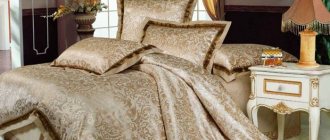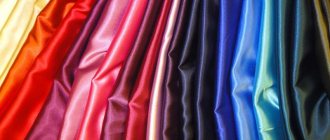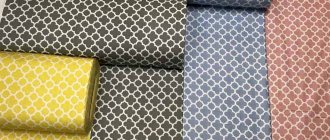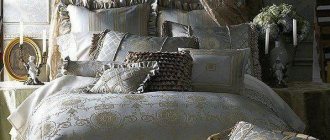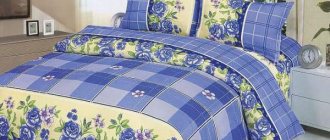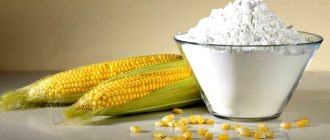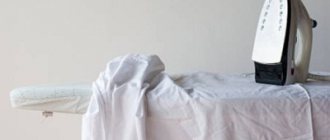Composition and density of the material
Stripe sateen contains natural cotton from which the fibers are made. Some manufacturers add special gold and pearlescent threads to give the fabric a beautiful look. Using cotton allows you to create a soft and pleasant fabric, which at the same time will be quite strong and reliable.
In production, only dyes of natural origin are used. First, individual threads for the fabric are dyed, and then the product is created from them. Typically, stripes are painted in calm, muted shades, but if desired, you can also find brighter models.
Most often you can find stripe satin in the following colors:
- Beige,
- Peach, light pink,
- Pistachio,
- Violet,
- White,
- Smoky,
- Light brown.
The density of the material can vary between 140-180 g/m2.
Description and composition
Photo No. 3 Champagne
Unlike jacquard, which is dominated by “floral” motifs, stripe satin is a more “strict” fabric.
Regular geometric shapes and patterns prevail here , but such material cannot be called monotonous and inexpressive: various combinations of stripes and patterns allow manufacturers to create ever new attractive and relevant models.
In the production of stripe satin, only natural dyes , which are not applied to the finished material, but are used to color individual threads before weaving.
As a rule, soft light colors are used to make stripe satin, but exotic bright models are often found.
Stripe satin consists of 100% cotton, which makes this fabric soft and pleasant to the touch, but at the same time dense and wear-resistant.
Advantages and disadvantages
pros
- Natural composition. The material is pleasant to the touch, so stripe satin bed linen is great for sleeping.
- Wear resistance. Special weaving allows you to create a dense fabric that will withstand a large number of washes. The material will last a long time while remaining in good condition. After washing, the laundry will not stretch or tear.
- Hypoallergenic product. Thanks to its natural composition, the fabric does not irritate the skin. In addition, bedding is suitable for those who often have an allergic reaction to synthetics. This is a great family option because the material is completely natural.
- Easy care. You only need to wash your clothes in a washing machine or by hand. It is better to iron things from the wrong side, and the product should be slightly wet. In general, the material does not require special care. Stripe satin does not wrinkle much, so you can do without ironing.
- The material is not electrified. Natural fabric has a great advantage compared to synthetics - the absence of electrification.
Minuses
- Insufficient air permeability. Due to the density of the fabric, it is better to lay it on the bed on cold days. The disadvantage is quite controversial, but some consumers say that on hot summer days it will not be possible to sleep on stripe satin.
- Slippery material. It is better to sleep on stripe satin in cotton clothes, which will avoid discomfort when moving.
Types of fabric
Classic stripe satin. The original version of this fabric is made of pure cotton.
- Mixed option. Manufacturers can still add various synthetic fibers to cotton: polyester, elastane or polyester. Typically, the share of synthetics is not more than 10 percent, since with a high content of such fibers, stripe-satin begins to electrify and becomes hard rather than silky.
However, there are mixed variations made only from natural fibers, for example, mycosatin. This soft fabric is made from cotton, to which bamboo or eucalyptus fibers are added. Wood threads are safe for allergy sufferers and people with sensitive skin. Mycosatin is thinner than classic stripe satin, so the level of breathability is much higher. In addition, the fabric absorbs water better.
Distinctive features of stripe satin from jacquard
Despite the fact that both fabrics have a natural composition, they have several differences. In terms of their properties, they are almost identical.
- Drawing. Jacquard usually has a floral print or pattern, while stripe satin has a geometric pattern that looks quite strict. Jacquard fabric is usually painted with a variegated pattern or a pattern of roses and other flowers is applied. The striped pattern on satin fabric appears due to the correct weaving of threads, and not by printing an ornament.
- Density. Jacquard is much denser (170-250 g/m2 versus 120-140 g/m2).
- Mercerization technology. Jacquard fibers are treated with a high concentration of sodium solution and then thoroughly washed. This is a great advantage, because the treated fabric will maintain a silky shine for a long time and will not lose color saturation.
Appearance and difference from satin
Satin is one of the most popular cotton fabrics in the world. There are several dozen of its modifications, designed for specific consumer characteristics. They differ from each other in thread twist, weaving types, design and preferred shades.
| Properties | Satin traditional | Stripe satin |
| patterns | floral, regular (polka dots, paisley, ornament) | stripes, strict geometry, squares, rectangles, rarely “braided” |
| weaving | with a predominance of weft on the face base | jacquard |
| threads | Variably colored, strong twist, occasionally double twist | pre-painted, double twist |
| density, g/m² | 100-120 | 120-220 |
Jacquard satin cotton is not only beautiful, but due to its weaving it is a strong, wear-resistant material. A separate category includes a subspecies with patterns in the form of stripes - stripe satin, the bed linen from which is superior in quality and tactile comfort to its cotton counterparts.
It’s interesting that stripe is actually a monochromatic material. And the stripes that seem to be of a different shade are not a painted pattern, but the result of interweaving the weft and warp threads according to the jacquard principle, a play of color.
Production technology and what is sewn from stripe satin
In the manufacturing process of fabric, two types of threads are used - warp and weft. Thanks to this, a geometric pattern appears on the surface. Warp threads, intertwined with each other, create an interesting ornament, and weft threads are used in places without relief. Both natural and synthetic dyes are used to add color to fabric.
Stripe satin is used for various types of objects: from interior details to clothing. The material has different densities, so its scope is quite wide. In particular, the fabric is used to make bed linen, towels and tablecloths. Thicker satin is used to make blankets and curtains that are perfect for English room design. Fabrics with a calm geometric pattern are typically used in business clothing, which is why satin is often used in office suits, dresses and other office clothes.
What is made from it
This type of satin is used for sewing various things:
- home textiles - bed linen, tablecloths, towels, curtains, bedspreads;
- lining for expensive outerwear;
- men's and women's shirts;
- dresses for girls and women;
- underwear;
- women's and men's business suits.
Bed linen made of thick white fabric is used in expensive hotels and sanatoriums. It is easy to care for and can be steam ironed.
Typically, buyers try to purchase not a finished product, but a piece of fabric. They are already making the necessary thing out of it. Therefore, you need to choose the right material.
How to choose stripe satin
Stripe satin differs in density, so the choice of the required type of fabric depends on the purpose, i.e. what products the fabric is purchased for. In order to sew a bedding set, satin with a density of 120-150 g/m2 is suitable. To make curtains, bedspreads or blankets, you need a denser fabric.
Clothes are made from fabric of any density; satin is used for outerwear, T-shirts and other things. Typically, the manufacturer indicates the density on the packaging (in the number of threads per cm/grams per square meter).
The best option is 110-180 threads per cm or 120 g/m2. If the exact indicator is not indicated, then you can check it by looking through the fabric at the light source. High-quality satin does not transmit a large amount of light, and the figures of people and objects are faintly visible through the fabric.
To find out whether a product is of high quality in a store, you should request a certificate of conformity. If its presence is noted on the packaging itself, then the product has passed the necessary checks and fully confirmed its natural composition. You should also pay attention to the brand. Most often, popular companies produce better quality products, since reputation is very important to them.
Note! Particular attention should be paid to the weight of the fabric. High-quality linen made from stripe satin cannot weigh much. The weight of a standard size bedding set is approximately 1 kilogram. The weight of the product may vary, depending on how dense the stripe was chosen, but in any case it cannot be too light.
Compound
The classic composition of stripe satin is 100% cotton, and the density is from 140 g/m2 to 180 g/m2. This provides the material with high performance characteristics: it is quite durable, but at the same time soft and pleasant to the body. There are no mixed fabrics, because the material production technology itself involves the use of only natural raw materials and dyes. That is why not only adults, but also children’s bedding sets, as well as blankets, are made from stripe satin.
The traditional pattern of the textiles in question is stripes created by alternating regular satin weaving and jacquard weaving. However, modern manufacturers offer more original solutions consisting of a variety of geometric patterns. This makes the fabric even more interesting and unusual.
How to wash stripe satin
The material is highly wear-resistant, so it can withstand several hundred washes in a washing machine or by hand. In order for the satin to last as long as possible, you must follow the following rules of care:
- The water temperature should be 40-60 degrees.
- Do not use products that contain chlorine and sulfates. Gentle detergents should be used for washing. If stripe satin is painted, then the bleaching elements in the composition of the products can worsen its appearance.
- Avoid washing with stiff types of fabric. It is better not to combine washing with other materials to avoid deterioration in the quality of the product.
- Before washing, turn the product inside out.
Important! Washing powders that contain chlorine can easily damage the soft structure of the fibers. Then, after a couple of washes, scuffs will appear on the fabric, which will worsen its external characteristics and the item will become worse. Stripe satin cannot be washed together with other textured fabrics. The interaction of satin with aggressive fibers can affect its quality and external characteristics. Rigid fabric can damage the natural fibers, causing pilling to form on the product that cannot be removed.
Stripe is used to make excellent bedding, which can be purchased as a set or purchased as a separate item. The standard size of linen for a 1.5-double bed is 145*215.
Note! If you have not found a suitable set, you can purchase fabric and make it yourself according to specific sizes and requests. This can happen if you need Euro-standard bed linen or another unusual format. Then you need to take into account the density of the purchased fabric.
Bed linen made from stripe satin will be an excellent gift for family and friends. The material has significant advantages over other fabrics, so it is excellent for sewing clothes, bedspreads, bed linen, etc.
Care instructions
- It is better to turn things inside out before washing.
- The maximum permissible water heating temperature is up to 90 degrees. Steaming with steamers is allowed.
- Do not use aggressive bleaching liquids. Choose formulations that do not contain chlorine and sulfates.
- Items are ironed inside out and slightly damp.
- The iron is set to the “Cotton” mode. The maximum heating temperature is 40 degrees.
- It is not recommended to dry items made from this fabric in the sun.
- When washing, do not mix items of different colors in the drum.
- To avoid the appearance of snags on the surface of the laundry, it is not recommended to wash it together with polyester fabrics and items decorated with rhinestones.
- It is recommended to store things either folded or straightened on a hanger. The place in which things will be stored should be well ventilated without high levels of humidity.
They also note that drying things in the open air gives things additional softness.
Proper care
Products made from stripe satin are very durable and tolerate all machine wash modes. However, their beauty lasts longer if:
- things are turned inside out before washing;
- high-temperature mode is used only if necessary, the first wash is always carried out at 40 degrees;
- use high quality detergents.
Bleach is used only for white fabric. Iron satin items from the inside out, slightly damp, in the “Cotton” mode.
What is made from this material?
Today many products are made from stripe satin. What exactly is it:
- bed linen (usually white, or fairly light shades);
- underwear;
- Men's shirts;
- children's and women's dresses;
- natural expensive lining;
- curtains and tablecloths, other home textiles.
Products made from striped satin look very elegant; moreover, they are comfortable to wear, especially in the summer, and are very durable. High-density bleached stripe satin tolerates washing on industrial washing equipment and ironing using a steam roller. Therefore, very often, such bed linen is used in sanatoriums, boarding houses, and expensive hotels.

